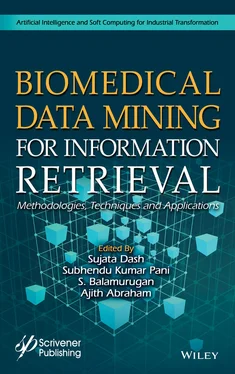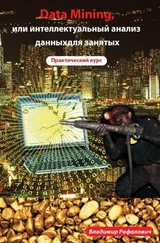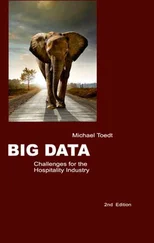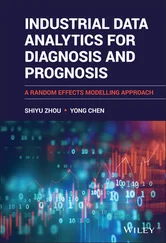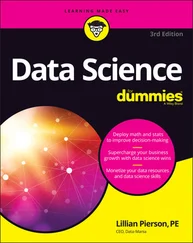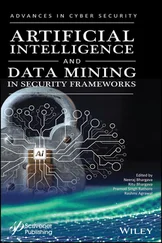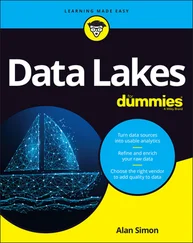1 ...6 7 8 10 11 12 ...20 Support Vector Machine [35] is a supervised machine learning algorithms which aims to find a hyperplane in the N-dimensional space. A plane which has the maximum margin is to be chosen. Vectors are information focuses that are nearer to the hyperplane and impact the position and direction of the hyperplane. Utilizing these help vectors, the edge of the classifier is expanded. Erasing the help vectors will change the situation of the hyperplane. These are the focuses that assist in building the SVM.
1.4 Result and Discussion
The results of all the models on testing set containing 1,000 records are shown in the Table 1.3.
As exhibited from the above table DT has outperformed the other five models with an accuracy of 97.95%. FA-FLANN model has secured the 2nd rank with an accuracy of 87.6%. DA, KNN and SVM models are giving almost same results with accuracy of 86.05%, 86.6% and 86.15% respectively. The worst result is reported for the Naïve Bayesian based model with an accuracy of 54.80%.
Table 1.3 Comparison of different models during testing.
| S. no. |
Model name |
Error during testing |
Accuracy |
Rank |
| Value |
(%) |
| 1. |
FA-FLANN |
0.1240 |
12.40% |
87.60% |
2 |
| 2. |
DA |
0.1395 |
13.95% |
86.05% |
5 |
| 3. |
DT |
0.0205 |
2.05% |
97.95% |
1 |
| 4. |
KNN |
0.1340 |
13.4% |
86.6% |
4 |
| 5. |
Naive Bayesian |
0.4520 |
45.20% |
54.80% |
6 |
| 6. |
SVM |
0.1385 |
13.85% |
86.15% |
3 |
In this chapter, different algorithms are presented to predict in hospital mortality based on the information collected at the hospital from the 48 h of observation. The data are selected from the PhysioNet challenge 2012 and used to predict in-hospital death. 4,000 records of patients have been selected of set A, from which 3,000 records of patients are used for training and other 1,000 records are kept for testing. 15 time series variables are selected out of 41 features for model development. Missing values are handled by imputing zeros. Six different models are developed for mortality prediction and a comparison is performed. It is observed from comparison that the decision tree is one of the best algorithms which obtained best accuracy result as compared to other five models used for the simulation study.
Many authors have accepted challenges of PhysioNet challenge 2012 and published many papers and found better accuracy results. Mortality prediction is still a challenging task to predict patient’s mortality in a hospital. Researchers are going on to develop some more models, other methods of handling missing data and make new strategies for mortality prediction. The performance of different other algorithms such as extreme learning machine, convolution neural networks and deep learning can also be used for the purpose in future.
1. https://en.wikipedia.org/wiki/Health_care
2. Hanson, C. and Marshall, B., Artificial intelligence applications in the intensive care unit. Crit. Care Med. , 29, 2, 1–9, 2001.
3. Halpern, N.A. and Pastores, S.M., Critical care medicine in the United States 2000–2005: An analysis of bed numbers, occupancy rates, payer mix and costs. Crit. Care Med. , 38, 1, 65–71, 2010.
4. Awad, A., Bader-El-Den, M., McNicholas, J., Briggs, J., Early Hospital Mortality Prediction of Intensive Care Unit Patients Using an Ensemble Learning Approach, CDATA. Int. J. Med. Inf. , vol. 108, pp. 185–195, 2017.
5. Kim, S., Kim, W., Woong Park, R., A Comparison of Intensive Care Unit Mortality Prediction Models through the Use of Data Mining Techniques. The Korean Society of Medical Informatics . Healthc. Inform. Res. , 17, 4, 232– 243, December, 2011.
6. https://physionet.org/content/challenge-2012/1.0.0.
7. Silva, I., Moody, G., Scott, D.J., Celi, L.A., Mark, R.G., Predicting In-Hospital Mortality of ICU patients: The PhysioNet/Computing in Cardiology Challenge 2012. Computing in Cardiology Conference (CinC) , vol. 39, IEEE, pp. 245–248, 2012.
8. Hosmer, D.W. and Lemeshow, S., Applied Logistic Regression , Wiley series in probability and statistics, 2nd Edition, John Wiley & Sons, Inc. 2000.
9. Johnson, D., Nic, M., Louis, T., Athanasios, K., Adrew, A., Clifford, G.D., Patient specific predictions in the intensive care unit using a Bayesian Ensemble. Computing in Cardiology Conference (CinC) , vol. 39, IEEE, pp. 249–252, 2012.
10. Lee, C.H., Arzeno, N.M., Ho, J.C., Vikalo, H., Ghosh, J., An Imputation-Enhanced Algorithm for ICU Mortality Prediction. Computing in Cardiology Conference (CinC) , vol. 39, IEEE, pp. 253–256, 2012.
11. Citi, L. and Barbieri, R., PhysioNet 2012 Challenge: Predicting Mortality of ICU Patients using a Cascaded SVM-GLM Paradigm. Computing in Cardiology Conference (CinC) , vol. 39, IEEE, pp. 257–260, 2012.
12. Xia, H., Daley, B.J., Petrie, A., Zhao, X., A Neural Network Model for Mortality Prediction in ICU. Computing in Cardiology Conference (CinC) , vol. 39, IEEE, pp. 261–264, 2012.
13. McMillan, S., Chia, C.-C., Van Esbroeck, A., Runinfield, I., Syed, Z., ICU Mortality Prediction using Time Series Motifs. Computing in Cardiology Conference (CinC) , vol. 39, IEEE, pp. 265–268, 2012.
14. Vairavan, S., Eshelman, L., Haider, S., Flower, A., Seiver, A., Prediction of Mortality in an Intensive Care Unit using Logistic Regression and a Hidden Markov Model. Computing in Cardiology Conference (CinC) , vol. 39, IEEE, pp. 393–396, 2012.
15. Yi, C., Sun, Y., Tian, Y., CinC Challenge: Predicting In-Hospital Mortality in the Intensive Care Unit by Analyzing Histograms of Medical Variables under Cascaded Adaboost Model. Computing in Cardiology Conference (CinC) , vol. 39, IEEE, pp. 397–400, 2012.
16. Kranjnak, M., Xue, J., Kaiser, W., Balloni, W., Combining Machine Learning and Clinical Rules to Build an Algorithm for Predicting ICU Mortality Risk. Computing in Cardiology Conference (CinC) , vol. 39, IEEE, pp. 401–404, 2012.
17. Severeyn, E., Altuve, M., Ng, F., Lollett, C., Wong, S., Towards the Prediction of Mortality in Intensive Care Units Patients: A simple Correspondence Analysis Approach. Computing in Cardiology Conference (CinC) , vol. 39, IEEE, pp. 469–472, 2012.
18. Macas, M., Kuzilek, J., Odstrcilik, T., Huptych, M., Linear Bayes Classification for Mortality Prediction. Computing in Cardiology Conference (CinC) , vol. 39, IEEE, pp. 473–476, 2012.
19. Di Marco, L.Y., Bojarnejad, M., King, S.T., Duan, W., Di Maria, C., Zheng, D., Murray, A., Langley, P., Robust Prediction of Patient Mortality from 48 Hour Intensive Care Unit Data. Computing in Cardiology Conference (CinC) , vol. 39, IEEE, pp. 477–480, 2012.
20. Bosnjak, A. and Montilla, G., Predicting Mortality of ICU Patients using Statistics of Physiological Variables and Support Vector Machines. Computing in Cardiology Conference (CinC) , vol. 39, IEEE, pp. 481–484, 2012.
21. Pollard, T.J., Harra, L., Williams, D., Harris, S., Martinez, D., Fong, K., PhysioNet Challenge: An Artificial Neural Network to Predict Mortality in ICU Patients and Application of Solar Physics Analysis Methods. Computing in Cardiology Conference (CinC) , vol. 39, IEEE, pp. 485–488, 20122012.
Читать дальше
